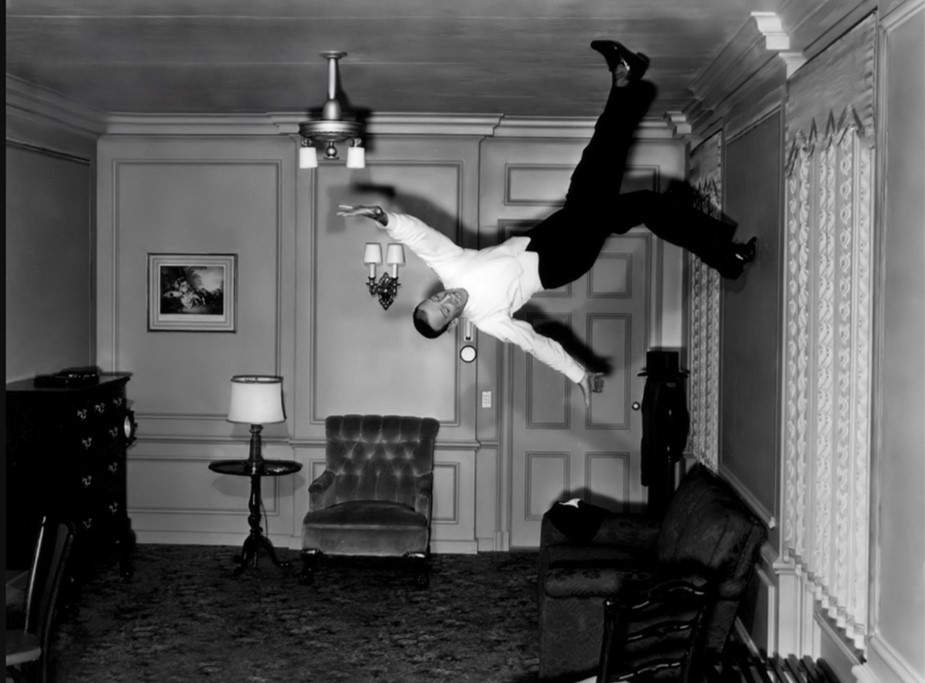Bending reality.

I am inspired by the curvature of space. Not necessarily by the physics that Einstein postulated early in the 20th century, but in a more personal way.
There is something in each of us that allows (and sometimes forces) us to bend the hard-edged realities that make up our daily lives.
Surely you’ve experienced this. Fall in love, and the world seems brighter. Smells intensify. The most mundane things become wondrous, and the world’s ugliness melts away. This is the condition that the philosopher Slavoj Žižek refers to as the virtual real. It’s what gives Fred Astaire the ability to dance on the ceiling in Royal Wedding, and if you haven’t experienced it at least once, you need to get out more often.
The converse happens when we experience pain, whether physical or emotional. On painful days, reality curves like a funhouse mirror, distorting our perceptions until the ugly things of life become disproportionally large, and beauty and joy shrink or vanish altogether.
Such magical transformations lie at the core of all fantasy – whether it is the kind we encounter in our daily lives or the worlds of fiction. Thus, when Fantasist Enterprises asked me to ponder where I encounter magic in my day-to-day existence, I began by considering where and when I first realized that my sense of wonder is rooted in the real. That’s the nice thing about writing prompts. They help you discover things you don’t know you know, and I’ve evidently known about the virtual real for quite a while.
Here’s a story.

I’m nine years old and living in Levittown, Pennsylvania, hanging out with my friends Tommy and Tommy. We’re sitting on the sidewalk outside one of our houses. It doesn’t matter whose house because the houses are all the same in Levittown, just as all the mothers and fathers and siblings and pets are all the same. Just like Tommy and Tommy are the same. There’s not much variety or excitement in that ticky-tacky town circa 1960, but there are popsicle sticks, and if you rub them against the sidewalk just right, you can turn them into swords.
We used to chase each other all over the neighborhood with those sharpened sticks, playing Count of Monte Cristo, poking and parrying and pretty much ignoring our moms when they shouted: “You kids are going to jab your eyes out.” We knew that couldn’t happen. We were invincible, safe in a world of imagination.
Here’s another.

Watching television in the late 50s and early 60s required considerably more imagination than it does now. These days, it’s all there for you in a million-plus pixels. Back then, an old black-and-white cathode-ray set with rabbit-ear antennae was more radio than television. You couldn’t see for crap when the reception was good. And when it was bad, say when an airplane was going over the house or someone was running a vacuum cleaner, all you got was visual static.
To give you an idea of how bad it was, one of my Tommy friends used to play Superman by stripping down to his underpants, tying a sheet around his neck, and drawing an S on his bare chest. I can still hear his mother shouting: “Get in here before you get arrested!”
Back then, I remember thinking that Tommy’s costume looked pretty authentic. Later, I was surprised to learn that George Reeves (TV’s Superman) had actually been wearing a unitard (a wrinkled one at that) and that the big bullet-repelling S on his pecs was not tattooed directly onto his skin. Somehow, knowing the truth made Superman less than super.
Likewise, it was years before I knew what Godzilla and King Kong were supposed to look like, and then I was amazed to discover that the monsters I imagined seeing on the blurry screen of our B&W Motorola were so much better than the ones that were actually in the movies.
The Virtual Real.
So how do these things play into my creative process?
I supposed it’s that my friends and I learned early on to find wonder in sticks and static. We learned that the things we created in our minds were as good as or better than the real wonders the world served up. Knowing that set me on the course of being a guy who bends reality by writing stories.
What awakens my wonder? That’s easy. It’s knowing that I have the ability and license to transform the ordinary.
It’s imagination.
[“The Virtual Real” originally appeared in the “Awakenings” blog at Fantasist.net, 24 Aug 2012. It’s reposted here as part of a series that recovers articles and essays written for external sites. See my previous entry Out of the Past for more details.]

Leave a Reply